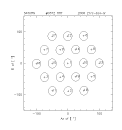
 Back to the SMT receiver page
Back to the SMT receiver page
In March 2000, a 19-channel bolometer array, developed at the MPIfR Bonn by E. Kreysa and collaborators, was installed at the HHT. It consists of 19 individual broadband continuum receivers, and is sensitive around a wavelength of 0.87mm (345GHz).
On this page we compile some information about this bolometer array, coming partially from test observations carried out in April/May 2000.
Array Layout
Bandpass
Sensitivity
In the submillimeter range, most of the noise is due to the atmosphere.
With proper data reduction, this atmospheric noise can be eliminated
to a certain degree. The remaining noise level is about
Even if this value is still preliminary, it can serve to estimate the observing time needed.
Remember that you have to add a certain overhead to the integration times estimated. Pointing and focus measurements, as well as maps of planets and skydip measurements for calibration purposes, may add up to 25 percent or more of the total estimated integration time |
Data Reduction
| The reduction of data taken with the bolometer can currently be done by two individual programs, MOPSI and NIC. MOPSI is developed by Robert Zylka (MPIfR Bonn/ITA Heidelberg) and can read the telescope raw data directly. The output format is NOD2. NIC is part of the Gildas software package and is mainly developed at IRAM Grenoble. It reads the Ascii-NMB data format, which is produced on-site by the HHT2NIC program, and writes the output in GDF format, which can be further processed by the GRAPHIC program. |
Last changed: November 3, 2000
Contact:
Michael Dumke
(mdumke@as.arizona.edu).